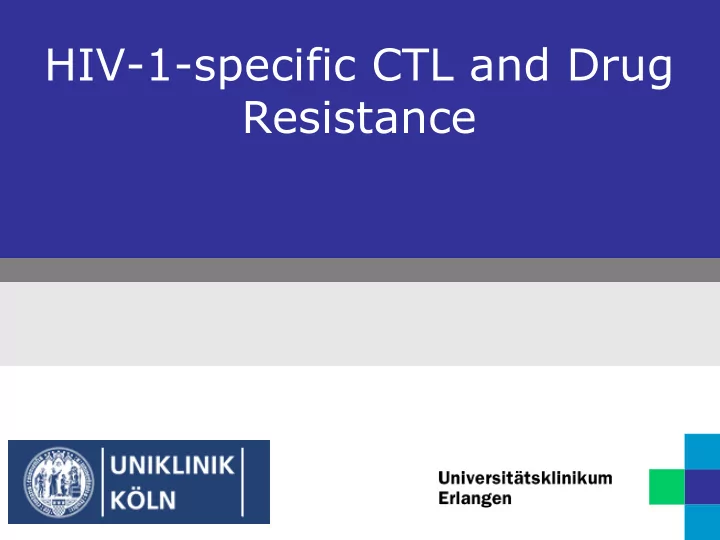

HIV-1-specific CTL and Drug Resistance
Aim of Studies – Interaction CTL/Resistance � Analysis of the influence of the immune system on sequence variation and drug resistance mutations in HIV-1 PR/RT � Cohort of 198 chronically infected HIV-1 patients � Do mutations occur more frequently/infrequently in patients with certain HLA types? � Does CTL recognition influnce the development of resistance mutations � Cooperation with Roland Kaiser’s group - analysis of patients from the RESINA study (n=73 therapy naive patients) � Is the maintenance of transmitted drug resistance mutations in treatment-naïve patients influenced by their HLA alleles? 2
Methods serological or/and genotypic HLA-typing was performed – � HLA A, HLA B and HLA Cw were determined HIV-1 PR and RT sequences are determined � univariate correlations were evaluated by Fisher’s exact test � results were verified in biological assays: � γ -interferon ELISPOT analyses restriction analyses standard Cr51 release assays 3
Interaction between CTL response and Development of Drug Resistance - Erlangen � Strong influence of CTL on protease polymorphisms and drug resistance mutations resistance mutations/polymorphisms correlating with HLA- types acted as escape mutations in most patients (JVi 2007, Mueller et al. ) � Of special interest: newly identified HLA B62 epitope KF9 (KMIGGIGGF aa 45 to 53 in PR) 70% of the B62+ patients showed strong recognition of the � epitope 4
Interaction between CTL and Development of Drug Resistance - Erlangen � Major drug resistance mutations are located within the B62 epitope KMIGGIGGF (KF9) KF9 (HxB2) KMIGGIGGF KF9-I (M46I) ( I DV,ATV,FPV,LPV,NFV) -I------- KF9-V1 (I47A) ( LPV) --A------ KF9-V3 (I47V) ( LPV,DRV,FPV,TPV) --V------ KF9-V4 (G48V) ( SQV,ATV) ---V----- KF9-V5 (I50V) ( DRV,FPV,LPV) -----V--- 5
ELISPOT analyses Patient 4 Patient 1 SFU/100.000 cells ----V---- ----V---- SFU/100.000 cells ---V----- ---V----- --V------ --V------ --A------ --A------ -I------- -I------- KMIGGIGGF KMIGGIGGF n.P. n.P. 0 100 200 300 400 500 600 0 200 400 600 800 1000 1200 1400 KF9 KF9-I KF9-V1 KF9-V3 KF9-V4 KF9-V5 Patient 8 SFU/100 000 cells ----V---- ---V----- • strong recognition of KF9 --V------ • none or very week recognition of KF9-V4 (48V) --A------ • strong recognition of KF9-V3 (47V) -I------- and KF9-V5 (50V) KMIGGIGGF n.P. • recognition of KF9-V1 (47A) and KF9-I (46I) 0 100 200 300 400 500 600 varies in the patients 6
Results KF9 � KF9 is a frequently targeted CTL epitope in HLA B6 2 -positive patients � The drug m utations 4 6 I , 4 8 V, 4 7 A strongly influence recognition of the KF9 epitope by B6 2 -restricted CTL � Only 6 / 3 7 B6 2 + patients show ed m utations w ithin KF9 , including 2 7 patients on PI treatm ent � Reason: strong fitness im pairm ent by m utations in KF9 ? 100% => in cooperation with Bernhard Thiele and Martin Däumer 454 50% sequencing will be carried out for the most interesting patients 0 Please send us blood sam ples from patients show ing 4 6 I , 4 7 A or 4 8 V no pre-selecting therapy + Pre-selecting therapy/"neutral HLA alleles HLA alleles" HLA Allele 7
Interaction between CTL and Maintenance of transmitted Drug Resistance – Köln (RESINA) Drug resistance associated HLA class I type P value Risk Ratio mutation L33F (PR) HLA-A*01 0.0440 9.1667 M46I/L (PR) HLA-A*03 0.0181 10.6 V75I (RT) HLA-A*11 0.0251 >100 K103R (RT) HLA-B*44 0.00046 23.0769 V118I (RT) HLA-B*07 0.0146 2.95 L210F (RT) HLA-B*44 0.0366 6.9231 Maintenance of Drug resistance mutations can be assigned to specific HLA alleles 8
Interaction between CTL and Maintenance of transmitted Drug Resistance – Köln (RESINA) B* 44 Sequence-wt: GQHRTKIEELRQHLLRWGFTTPD L210F: EELRQHLFRW L210W: EELRQHLWRW AZT mutation Pat 20 HLA A24, A24, B44, B13, Cw5, Cw6 Known HLA B44 epitope 210F is an escape mutation 9
Results RESINA cohort � Correlations between HLA class I alleles und the maintenance of drug resistance mutations in treatment-naïve patients � peptides comprising these aa positions were recognized by CD8 + T cells � 210F acts as escape mutation in B44 + patients � selection for this mutation may occur in B44 + patients 10
Thanks to… Thom as Harrer Rolf Kaiser Kathrin Eism ann Finja Schw eizer Silke Bergm ann and collegues Pia Rauch Ellen Harrer RESI NA Hauke W alter Bernd Spriew ald DFG,I ZKF, Hector Stiftung Thom as‘ Group in Erlangen HI V Kom petenznetz Martin Däum er and the Laboratory Bernhard Thiele, Kaiserslautern All Patients taking part in these studies 11
Thank you for your attention … and please don’t forget to send us blood sam ples from patients show ing 4 6 I , 4 7 A or 4 8 V ;-) 12
13
Interaction between CTL and Maintenance of transmitted Drug Resistance – Köln (RESINA) Epitope mapping sequence comparison with known peptide binding motifs or epitope prediction � tools (ELF, SYFPEITHI) ELISPOT analyses with overlapping peptides � � cells are stimulated with peptides including the aa position which displayed a correlation to a HLA allele and tested for cross recognition of the neighboring peptides Statistic: correlation between V118I and HLA B7 Pol69 VPLDKDFRKYT KDFRKYTAFTIPSIN_70 SFU/100 000 cells VPLDKDFRK (B*0703 .[P].......) VPLDKDFRK (B*0705 .[P].......) V PLDKDFRKYTAFTI_69 http://www.hiv.lanl.gov/cgi-bin/ELF/epitope_analyzer.cgi AYFS V PLDKDFRKYT_68 n.P. 0 50 100 150 200 14
Summary (both studies) The HLA-system plays a role in m aintenance of transm itted drug resistance m utations in treatm ent-naïve patients and influences the developm ent of resistance m utations in chronically infected patients 15
Restriction Analyses, Standard Cr51 Release Assays Patient 4 A2, A3, B57, B62, Cw3, Cw6 Patient 9 A2, A3, B27, B62, Cw3, Cw2 no peptide % specific cell lysis +KF9 control +A2 SFU +A3 +B62 +Cw3 KF9 Clone + B62 B cell +B57,Cw6 +Cw6 0 100 200 300 400 500 600 0 10 20 30 40 50 60 Identical results were obtained using CD8 + cells stimulated with the peptides Including the Mutations at position 46, 47 and 50 CTL specific killing of HLA B62 can present all antigen presenting cells variants apart from peptides including 48V 16
Recommend
More recommend